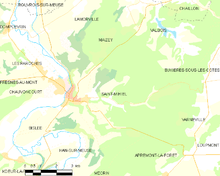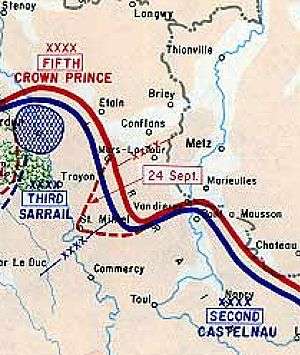Battle of Flirey
The Battle of Flirey (French: 1re Bataille de Flirey) was a First World War battle fought from 19 September – 11 October 1914. It resulted in a German victory against the French army. The battle cut most of the roads and railways to the strategically important Fortified Region of Verdun (Région Fortifiée de Verdun [RFV]) and was to have a large effect on the course of the war.
Background
The Woëvre Plain stretches from the city of Luxemburg, south to the French city of Toul and has been a common route of attack between Germany and France. The plain is flanked on the western side by a series of mountain ranges (the Hauts de Meuse) along the Meuse River and along the eastern side by a series of mountain ranges along the Moselle River. A series of German fortifications were built before the war, along the Moselle (especially around the city of Metz), while across the border, a matching set of French fortifications was established along the Meuse around Verdun and Toul.
In the first months of the First World War, the Oberste Heeresleitung (OHL: German High Command) were the first ones to realise the increased effectiveness that artillery and machine-guns gave to the defence and seized various terrain features that would be easy to defend. Recognising that it is easier to defend the heights alongside the Meuse (as opposed to the plain between the Moselle and Meuse), a German attack was planned to seize the heights, to deny access to the Woëvre Plain to the Allies, isolate Verdun and reduce the ability of the French to attack German territory.
Battle
The attack commenced on 19 September, with German cavalry from Metz skirmishing with the French defenders in the Dieulouard–Martincourt area. Flirey, the woods around the village and Seicheprey were quickly captured. French reinforcements arrived on 22 September but could not stop the Germans from advancing. The German advance then changed direction, moving from southerly to south-west. By 24 September, the town of Saint-Mihiel was captured and villages of Flirey, Seicheprey and Xivray recaptured. More French reinforcements arrived on 27 September but as the Germans were now firmly entrenched, French counter-attacks between Flirey and Apremont resulted in little change in the front line. French counter-attacks continued until 11 October.
Aftermath

The battle created a salient projecting into the French lines south of Verdun, named the St Mihiel Salient. Of the two roads and one railway that led to Verdun, all but a minor road were closed, which imposed severe supply difficulties on the French troops in the RFV. The city was enveloped on three sides and neutralised as a base for French offensive operations. The area was to see much fighting over the rest of the war. Despite attempts by the French to reduce the salient in the First Battle of Woëvre in early 1915, the First Offensive Battle of Verdun in late 1916 and the Second Offensive Battle of Verdun in 1917, the salient was not reduced until the Battle of Saint-Mihiel in September 1918.
References
Sources
- Der Herbst-Feldzug 1914: Im Westen bis zum Stellungskrieg, im Osten bis zum Rückzug. Der Weltkrieg 1914 bis 1918: Militärischen Operationen zu Lande (in German). I (Die Digitale Landesbibliothek Oberösterreich ed.). Berlin: Mittler & Sohn. 2012 [1929]. OCLC 838299944. Retrieved 5 February 2014.
- Doughty, R. A. (2005). Pyrrhic Victory: French Strategy and Operations in the Great War. Cambridge, Massachusetts: Belknap Press. ISBN 978-0-674-01880-8.
- Herwig, H. (2009). The Marne, 1914: The Opening of World War I and the Battle that Changed the World. New York: Random House. ISBN 978-1-4000-6671-1.
- Strachan, H. (2001). To Arms. The First World War. I. Oxford: OUP. ISBN 978-0-19-926191-8.
- Tyng, S. (2007) [1935]. The Campaign of the Marne 1914 (Westholme ed.). New York: Longmans. ISBN 978-1-59416-042-4.

